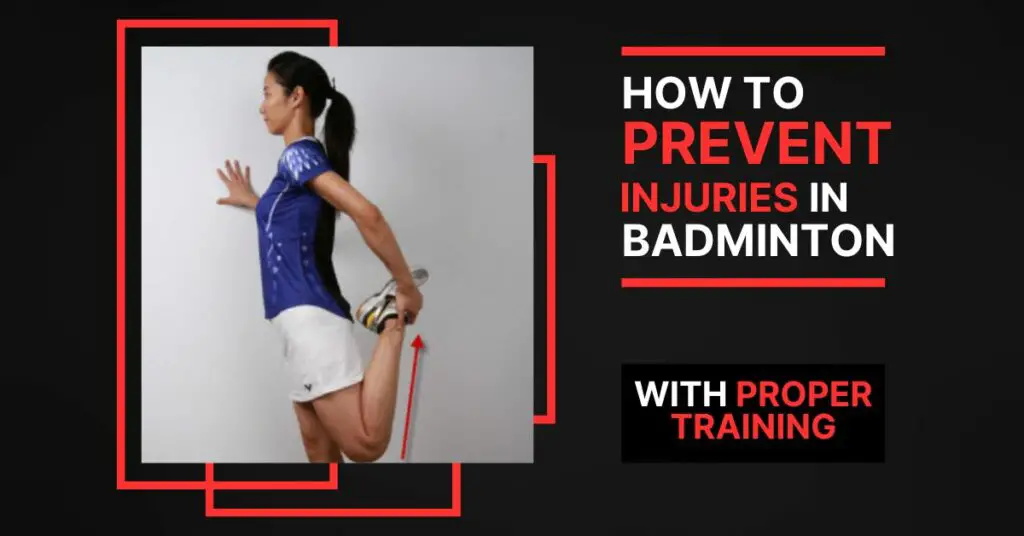Getting injured is one of the worst things that can happen to any athlete. Injuries often prevent you from training for weeks, and when you are ready to go back into training, you have to start from a very light level. It’s almost like a complete reset of all your progress.
Additionally, some injuries also have long-lasting effects on your ability to play, which can be extremely frustrating to play with. Undoubtedly, we want to prevent injuries the best we can, and one of the ways is through proper training. In this article, I will show you how to prevent injuries in badminton with proper training.
How Injuries Happen
First, let’s talk about how injuries happen. Generally, injuries occur when you push your body into uncomfortable positions at loads it cannot handle.
In badminton, this occurs frequently in situations like when you have to lunge deeply into a position you’re not used to. Since badminton is such a fast game, you often put crazy stress on your body trying to move as fast as possible.
Apart from working on your technique and court stability, here are some pieces of training advice to help you build strong muscles and joints to prevent yourself from getting injured.
Train With Progressive Overload
One of the most important things you must do is train with progressive overload. It will probably not end well if you have never done squats and suddenly jump on the squat rack with two plates.
Yet, so many people jump into super intense training they’re not used to and get injured. My brother was one of them and could not train to his full potential for an entire year due to knee issues.
For any training, you have to work your way up. Start light, see what your body can handle, and slowly increase the training intensity.
Slowly Go Full Range Of Motion
Another training tip is to include sessions where you do exercises with full range of motion. For example, if you are lunging, go as deep as possible. The key is making these movements very slow and using either no weights or very light weights. Also, incorporate good stretching routines after all training sessions to develop flexibility.
By going your entire range of motion, you extend the capabilities of what positions your body can get into. Using the lunging example again, you won’t get injured from deep lunges if your body is already accustomed to deep lunges.
The same goes for every other movement in badminton. How can you get injured if your body is comfortable with all the uncomfortable positions?
Isometrics And Other Joint Strengthening Exercises That Are Light On The Joints
Badminton is a sport that’s very intensive on the joints. Since you’re always hopping and jumping on the court, you wear out joints such as your knees and ankles very fast. Depending on the surface you train on, the stress is bigger or smaller. Hard surfaces such as concrete will send much of the impact from your movements back into your body, while softer surfaces that absorb the impact will stress your joints less.
To strengthen your joints without stressing them, add training sessions that are light on the joints but help you build the muscles that support your joints. Isometrics like wall sits and standing on one leg with your eyes closed are great exercises to help develop the muscles around your joints without actively exposing your joints to stress since you’re not receiving shock from your explosive movements.
Other great exercises also include swimming and training in the sand. Since water and sand are great at absorbing impact, you can train your muscles without shocking your joints.
Adding a few isometric and strength sessions that are light on your joints can go a long way in developing your muscles without injury and prepare you for the more joint-intensive sessions.
How To Prevent Injuries In Badminton With Proper Training
I hope you were able to take something away from this article on how to prevent injuries in badminton with proper training. To sum things up, remember to slowly ramp up your training, practice moving your entire range of motion, and do strengthening sessions that are light on your joints.
Doing this, along with good warm-up and cooldown routines, will drastically reduce your risk of getting injuries, which is crucial if you want to improve at badminton. Remember, injuries are the most significant setbacks in training. You would rather train lighter and slowly improve than go as hard as possible and break yourself.
As always, if you have any questions or comments, please leave them in the comment section below!

